In Los Angeles, a terrified immigrant sits inside a truck as a masked man swings a baton, shattering his window.
In Baltimore, agents break a window and grab a man by the neck, pulling him out of his car.
ICE says its officers “use only the level of force that is objectively reasonable.” Across America, what’s “reasonable” has changed.
“We’ll Smash the Fucking Window Out and Drag Him Out”
This story contains videos and descriptions of violent arrests.
A month into the new Trump administration, on the predawn streets of suburban Maryland, a high-ranking ICE official stood alongside a Mazda sedan that his officers had just stopped.
The official told a local TV reporter at the scene what was about to happen. “He can either give us a license,” he said, “or we’ll smash the fucking window out and drag him out.” Then, as the driver refused to exit the car, officers broke the glass.
It was one of nearly 50 documented instances of immigration agents breaking vehicle windows that ProPublica has identified from social media, local news accounts, lawsuits and interviews since President Donald Trump took office six months ago. Using the same methods, we found just eight in the previous decade. Neither number is comprehensive. The government releases no relevant statistics.
Use-of-force experts and former Immigration and Customs Enforcement insiders say the tactic was rarely used during previous administrations. They say there is no known policy change greenlighting agents’ smashing of windows. Rather, it’s a part of a broader shattering of norms.
There are arrest quotas, and they are increasingly aggressive. “There’s been an emphasis placed on speed and numbers that did not exist before,” says Deborah Fleischaker, who served as ICE chief of staff under President Joe Biden.
Officers who break glass aren’t being disciplined — they’re being promoted. The official from Maryland, Matthew Elliston, now occupies a senior position at headquarters and oversees field operations on the East Coast. On the other side of the country, a Border Patrol chief who also embraced the tactic, Gregory Bovino, was put in charge of sweeps in Los Angeles. (Neither answered ProPublica’s questions.)
ICE says its officers use a “minimum amount of force” when making arrests. You can judge for yourself.
What We’re Seeing
Agents break car windows even when sobbing children or pregnant women are inside.
Spokane, Wash. • March 10, 2025
“She is pregnant!” a man yelled as his wife, a U.S. citizen, filmed from inside their Chevy. “Is pregnant! Is pregnant!”
Officers smashed through three windows to arrest Jeison Ruiz Rodriguez and his younger brother César in early March. The video was not the first under Trump — at least nine broken-windows arrests preceded it this year, some documented by Facebook posts or local reporters or Spanish-language TV.
Chelsea, Mass. • May 11, 2025
On Mother’s Day in the Boston suburbs, ICE and FBI officers stopped a family on their way to church, threatening Daniel Flores-Martinez with what the family and a bystander believe was a gun. His three children and U.S. citizen wife sobbed in the car. Agents broke the window, forced Martinez to his knees, then slammed him roughly to the ground.
One of the children is a toddler. Another is a 12-year old with severe disabilities.
The incident was captured by then-high school student Kenneth Santizo, who was nearby waiting for his bus. “All I could hear was kids crying,” Santizo said.
What We’re Seeing
People reported bloodied faces, bleeding arms and other injuries after agents smashed through the glass.
La Puente, Calif. • June 26, 2025
Last month, a bystander filmed several masked agents using a baton to break a rear window of a white pickup truck, taking the driver to the ground and pressing his head forcefully into the asphalt. The man, last seen in the video bleeding from the head, has not been identified.
Watertown, Mass. • May 5, 2025
On a residential street in May, agents smashed through two windows of a Ford Focus to arrest the two men inside. A neighbor filmed from inside their home as one man, later identified by WBUR as Guatemalan immigrant Kiender Lopez-Lopez, struggled with masked agents. (He had previously been charged with domestic violence but was not convicted.) Several of them tackled him on the sidewalk while he screamed for help. The government released no information about the arrest, despite repeated requests from WBUR and ProPublica.
At least 10 people have said they were injured this year during broken-windows arrests. César Ruiz Rodriguez had an open wound at the back of his head when he arrived at detention from Spokane, Washington, his lawyer said, and X-rays showed glass in the knees of his brother Jeison. ICE claimed that the Nicaraguan-born brothers were members of the Venezuelan gang Tren de Aragua. Both men have denied any gang affiliation. We found that the brothers had been accused of threatening a family member, but prosecutors dropped the charges.
In Kentucky, agents stopped Martin Rivera and his girlfriend, Jennifer Gribben, a U.S. citizen, while the agents searched for a fugitive. “You said you’re looking for Garcia,” Rivera said in a scene the couple broadcast on Facebook Live and have since deleted. One of the agents replied, “And I found you instead.”
Then they smashed through the car’s window. Gribben later wrote on Facebook that she was beaten “brutally in my head” and that officers broke Rivera’s arm. She pleaded not guilty to charges of resisting arrest and third-degree assault stemming from the incident.
Near Detroit, masked ICE officers dragged 49-year-old Veronica Ramirez Verduzco, an aide at an assisted-living center, out of her car through a window they broke. Ramirez Verduzco still had bloody, jagged scratches up and down her forearms five days later, her lawyer said.
ICE told ProPublica that agents are allowed to use force when civilians don’t follow their commands. But Ramirez Verduzco and others said they were given little time to respond before officers broke their windows.
“They didn’t give me a chance to understand what was going on,” she said in an interview shortly before she was ordered deported to Mexico.
What We’re Seeing
Officials claim they target the “worst of the worst.” But they’re breaking windows to arrest people who don’t have criminal records.
In one case, ICE said a 51-year-old mom was connected to the MS-13 gang.
Westminster, Md. • March 31, 2025
This spring, ICE arrested Elsy Noemi Berrios after breaking her car window, scattering glass over her patterned dress. Her teenage daughter screamed and cried as she filmed with her cellphone. An officer helped Berrios shake off the glass and step out of the car. “Gracias,” she said. Then he put her in handcuffs.
After the video went viral and outrage spread, the agency put out a statement asserting that Berrios, a Salvadoran national, was a “known affiliate of the violent transnational street gang, MS-13.” Our review of judicial records — both federal and local — found no criminal history for Berrios and no other evidence to support this claim.
This July, in another widely circulated case, officers stopped an Iranian chiropractor and green-card applicant near Portland, Oregon. He was on his way to his toddler’s preschool. “There is a baby in the car,” the man said. They allowed him to continue to the school, then broke a window once the toddler was out. We found no criminal history for him.
Your car is a constitutional gray zone. It doesn’t have the same Fourth Amendment protections as homes. You can refuse to open the door of your home if officers don’t have a judicial warrant; you can’t refuse to step out of your car.
The Constitution still limits when officers can use force and how much they can use. But there are no firm rules. Should they shatter windows just minutes or seconds after making a vehicle stop? Should they drag someone through broken glass when they could wait to make the arrest another day?
“Use of force has to be objectively reasonable,” says Bruce-Alan Barnard, a retired Fourth Amendment instructor at the Federal Law Enforcement Training Center in Georgia, where ICE officers train. The problem with “objectively reasonable,” Barnard says, is that “it’s an oxymoron. What’s reasonable to you might not be reasonable to me.”
Immigration officers are given little guidance on whether or how they should breach car windows, former federal law enforcement officials told ProPublica. The tactic was never prohibited. It was just rare.
It isn’t mentioned in the government’s use-of-force guidelines for immigration agents. And past instructors and students at the Georgia training center say it was never part of the curriculum.
What We’re Seeing
Often, civilians whose windows are smashed aren’t agents’ intended targets. Some are American citizens.
New Bedford, Mass. • April 14, 2025
In Massachusetts this spring, a tall ICE officer in a trucker’s cap swung a sledgehammer to arrest Juan Francisco Méndez, the Guatemalan asylum-seeker inside. Officers had stopped the car looking for an “Antonio,” his wife told the New Bedford Light. Méndez has no known criminal record.
He and his wife told officers they were waiting to exit the car until their lawyer could arrive. Before the sledgehammer swung, one of the officers threatened them in broken Spanish: “We can do it two ways. Hard or easy?”
An ICE spokesperson told ProPublica that the agency “concurs with the actions deemed appropriate by the officers on the scene.”
Rochester, N.Y. • June 17, 2025
In June, a 15-year-old girl and her mother watched as ICE agents stopped a work truck and roughly arrested several men.
“For the last time, are you opening this, or no?” an officer warned before he broke the glass. “I’m fucking blasting it right now.”
While the teenager yelled and asked the officers if they had a warrant, the driver turned toward her camera and said he was a U.S. citizen.
Early this year, border czar Tom Homan made one of his now-familiar threats to a sanctuary jurisdiction, promising to bring “hell” to the Boston area. To do that, his immigration officers needed help.
An ICE press release soon touted its collaboration with a half-dozen other federal agencies, including the Coast Guard and State Department, on a monthlong crackdown in the region, dubbed Operation Patriot. (The Coast Guard confirmed that it helped transport people arrested on Martha’s Vineyard and Nantucket. The State Department also confirmed its role. Neither commented further.)
In May, bystanders filmed in nearby Waltham, Massachusetts, as masked agents from the Drug Enforcement Administration and Homeland Security Investigations, along with agents from unidentified agencies, questioned two men parked in a work van. “Show me you’re here legally and I’ll leave you alone,” said one officer, identified on his vest only as “federal agent.”
In the months since, federal officers from other agencies have continued to participate in immigration operations around the country.
What We’re Seeing
We don’t know who these masked officers are or, often, even which agency they’re from, or who can be held accountable.
Elgin, Ill. • Jan. 28, 2025

Westminster, Md. • March 31, 2025
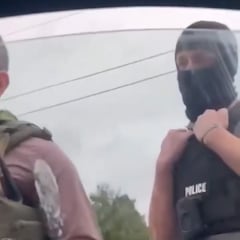
Watertown, Mass. • May 5, 2025
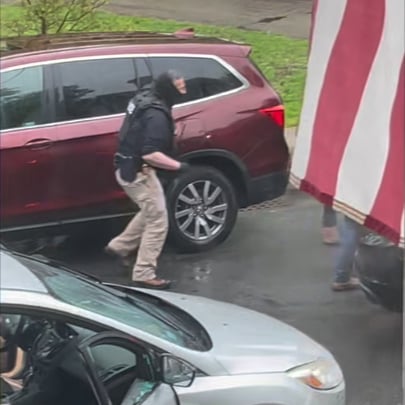
Waltham, Mass. • May 13, 2025
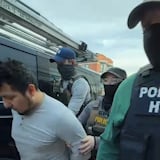
Marlborough, Mass. • May 20, 2025
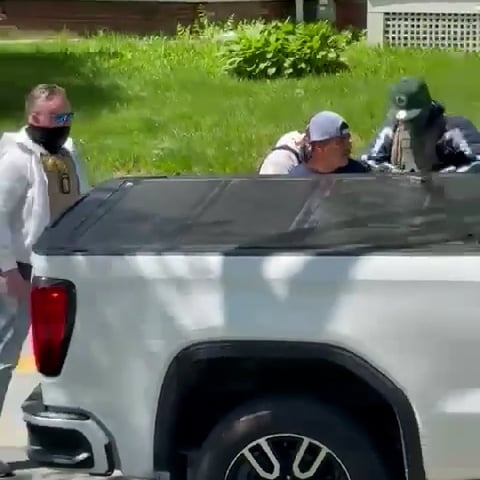
Los Angeles, Calif. • June 19, 2025
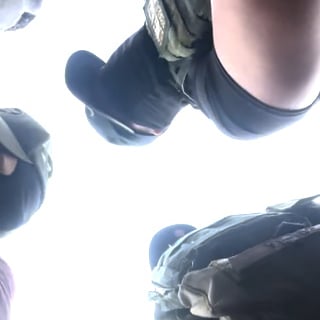
La Puente, Calif. • June 25, 2025
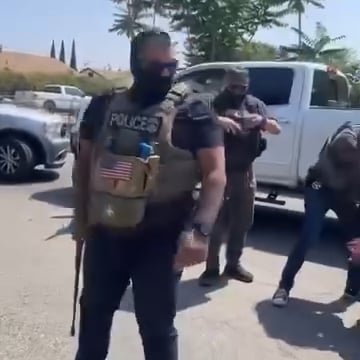
Baltimore, Md. • July 10, 2025
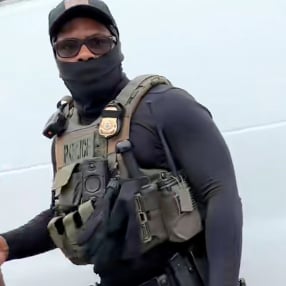
What happens if officers cross the line? Usually very little.
Paths to suing federal officers are even more limited than for police officers, making it particularly hard for immigrants to hold officers accountable for any misconduct.
“The deck is stacked against them,” says Fleischaker, the former top ICE official.
Even if a judge decides to award damages, that usually won’t change what happens — or already happened — in the separate system of immigration court. Evidence of a violent arrest rarely stops a deportation, and if people have already been deported, it won’t bring them back.
In the instance of the family detained on Mother’s Day, they filed a complaint over “unlawful and excessive” actions — but the father has already been deported to Mexico. (The government has not responded to the complaint or to ProPublica’s questions about it.) A precursor to a full civil lawsuit, the complaint says their 3-year-old now tells people, “Police broke the window and threw daddy on the floor.”
Settlements in similar cases have been small. A California woman detained by Border Patrol in 2016 after agents broke her car window while her children screamed settled two years later for $25,000.
When we asked the White House detailed questions about the tactic and specific incidents, it stood by officers’ conduct. “ProPublica is a left-wing rag that is shamelessly doing the bidding of criminal illegal aliens,” deputy press secretary Abigail Jackson said in a statement. “ICE Officers are heroically getting these violent illegal aliens off of American streets with the utmost professionalism.”
Department of Homeland Security Assistant Secretary Tricia McLaughlin also defended the tactic in response to questions about Border Patrol. Officers “may break vehicle windows” if occupants don’t follow their commands, she said. In June, an ICE spokesperson told ProPublica, “Our officers follow their training to use the minimum amount of force necessary to resolve situations in a manner that ensures the success of the operation and prioritizes safety.”
Other agencies whose officers were involved in incidents we documented — FBI; DEA; and the Bureau of Alcohol, Tobacco, Firearms and Explosives — did not respond or declined to comment on specific cases.
What We’re Seeing
Officers are arresting bystanders, too. But they’re still filming.
Los Angeles, Calif. • June 19, 2025
Bystanders who film these videos do so at no small risk to themselves.
Job Garcia, a 37-year-old Ph.D. student and U.S. citizen, was filming an immigration raid in June near a Home Depot in Los Angeles when Border Patrol agents broke the window of a truck to detain the man inside. Then, agents turned on Garcia.
The Mexican American Legal Defense and Educational Fund filed a complaint against the federal government on Garcia’s behalf in July, alleging agents detained him in retaliation for recording and because he was Latino.
In response to our questions, DHS’ McLaughlin claimed Garcia “assaulted and verbally harassed” Border Patrol. (No assault is shown in the video.) McLaughlin added, “He was subdued and arrested for assault on a federal agent.”
Kayden Goode, the 15-year-old girl who filmed the arrest of the U.S. citizen in Rochester, New York, said she felt compelled to record despite the risk.
"I don’t think it was right,” Goode said. “Just because something is legal doesn’t mean that it’s right.”
Sometimes just the threat of window smashing is enough. One Afghan asylum-seeker who stepped out of a car after ICE threatened his window said in an affidavit, “It reminded me of the Taliban.”
But this all may be only the beginning. Shortly before Trump’s flagship domestic policy bill passed in early July, border czar Tom Homan told a conservative Christian conference that immigration agencies were just getting started. The law will triple the size of ICE and add thousands more immigration agents.
“You think we’re arresting people now?” Homan said. “You wait.”
How We Did This
Earlier this year, reporter Nicole Foy heard about Border Patrol officers near Bakersfield, California, smashing a car window. Reporter McKenzie Funk also noticed immigration agents using the tactic in Washington state. The federal government does not publicly track how often agents break car windows, nor did government officials agree to requests to speak about it.
In the months that followed, Foy and Funk documented dozens of cases by searching social media, local news and legal filings. They spoke to current and former law enforcement officials, experts in constitutional law and advocates across the country and contacted the agencies of officers involved in the incidents.
Along with research reporter Mariam Elba, they also looked into the backgrounds of the identified individuals whose immigration arrests are shown in this story. They searched for records in the criminal courts of the counties in which the arrest took place, as well as in the counties public records show the person previously lived in. We found one criminal conviction among those people: Veronica Ramirez Verduzco was convicted of reentering the country illegally.
The findings on criminal records are not comprehensive because there is no universal database of charges or convictions, and there was not enough identifying information for some people. When the government made claims about an individual, Foy and Funk asked them for supporting evidence. They did not provide any.
How to Help Us
Do you have information or videos to share about the administration’s immigration crackdown? Contact Nicole Foy via email at [email protected] or on Signal at nicolefoy.27 and McKenzie Funk via email at [email protected] or on Signal at 212-379-5757.
Design and development by Anna Donlan, visual editing by Shoshana Gordon, research by Mariam Elba and reporting by Rob Davis. Additional production by Lucas Waldron.